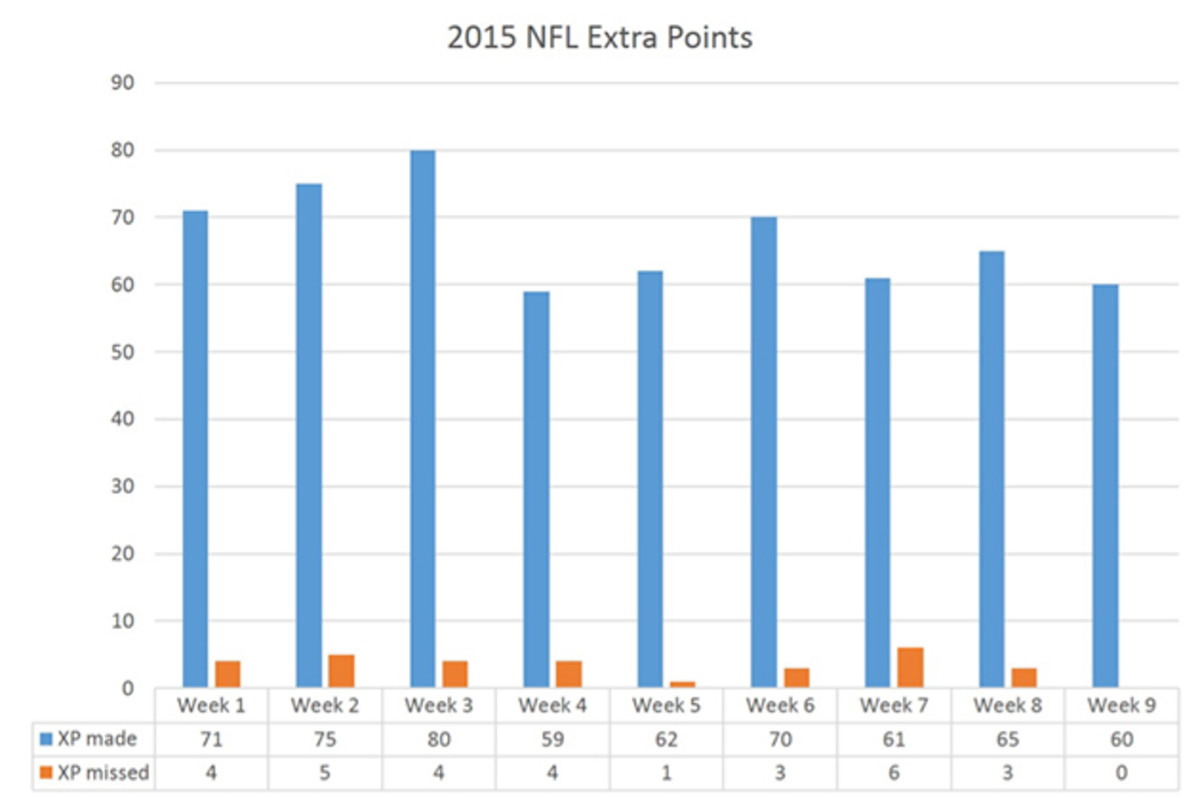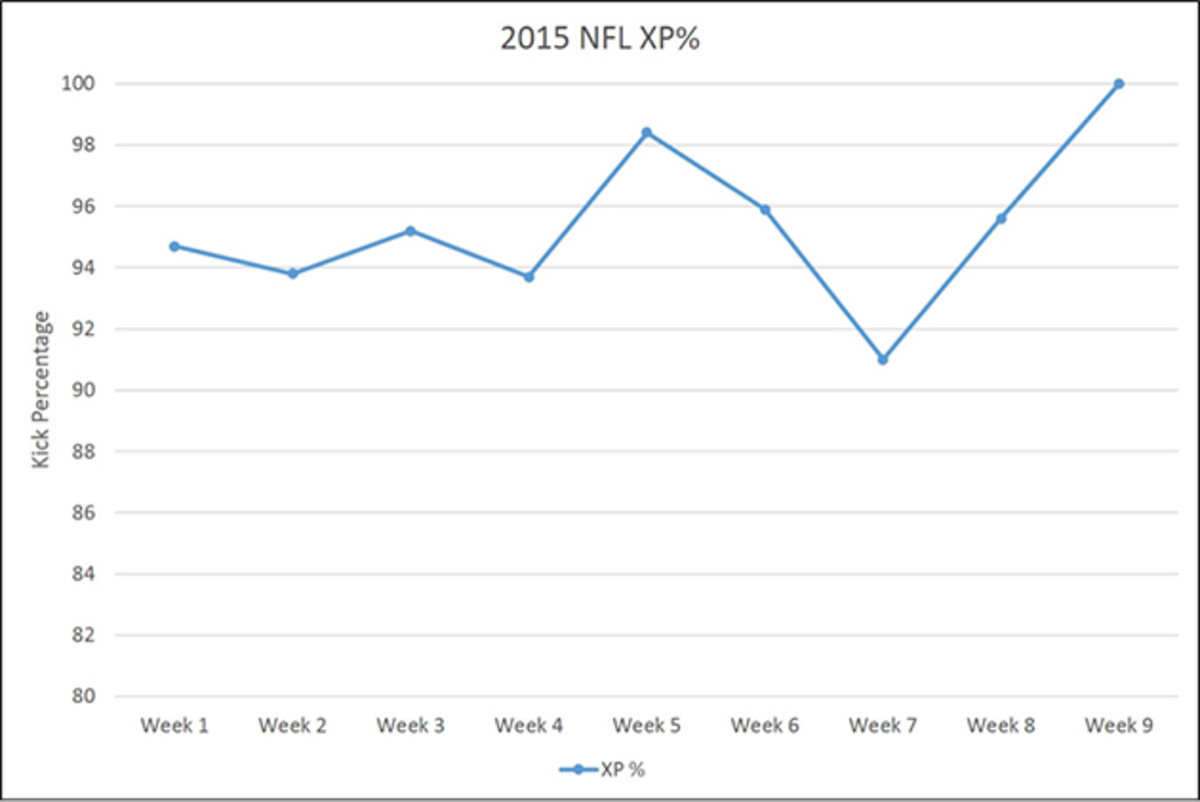On The Numbers: Williams's standout day, a perfect week for PATs, more

Welcome to Week 9 of “On the Numbers,” a weekly column that mines for statistical oddities, numerical fun facts and analytical observations from around the NFL.
On a week that saw Ryan Tannehill rack up nine receiving yards, Blaine Gabbert outrush Devonta Freeman and Tom Brady get credited with a tackle, there was plenty to track across the league.
• News, highlights, injuries, videos and more from NFL's Week 9
Feats of Strength
I can’t write about Antonio Brown every week. (I mean, I probably could, but I’m not allowing myself to.) Yes, he caught 17 passes for 284 yards and ran for 22 more, but I’ve written enough about him already this season.
So I searched far and wide for somebody else to spotlight in this week’s Feats of Strength, and found somebody who shares Brown’s huddle: DeAngelo Williams.
Williams, the hottest commodity on your waiver wire this week, and the man being counted on to somehow replicate Le’Veon Bell’s production, actually exceeded expectations this week. The first-round draft pick in 2006 tallied 27 carries for 170 yards and two touchdowns, and added two catches for 55 yards for good measure. We haven’t seen this kind of production from Williams on a consistent basis since his prime in Carolina in 2008 and '09.
Week 9 Snaps: Colts turn page on ugly start to year in win over Broncos
If you’re thinking, “Gosh, that seems like a long time ago,” … you’re right. Some of the running backs who outgained Williams in 2008 include Michael Turner, Clinton Portis, Thomas Jones and Jamal Lewis.
But you blinked and DeAngelo Williams is now an old man (by modern NFL running back standards at least). How old is he? He was 32 years and 198 days old on Sunday, to be precise. And on Sunday he supplanted Walter Payton as the oldest player to rush for 170 yards in a game during the Super Bowl era. Payton ran for 177 yards at 32 years and 51 days old in a 1986 Bears win over the Eagles.
A 35-year-old John Riggins is the only player older than Williams to rush for even 150 yards in the Super Bowl era, when he ran for 165 in a 1984 Redskins win over the Cowboys.
Williams also had those 55 receiving yards, giving him an eye-popping 225 yards from scrimmage. The list of players older than him to notch 225 yards in one day is short and populated entirely by Hall of Fame wide receivers: Steve Largent, Don Maynard and Jerry Rice. Pretty good company!
• KING: MMQB—How Minnesota's unorthodox OT decision helped them win
Here’s the full list of players with 225 yards from scrimmage at any point in their 30s, and the number of times they’ve done it:
<p> </p> | <p>PLAYER</p> | <p>YEARS</p> | <p>TEAM</p> | <p>NO.</p> |
|---|---|---|---|---|
1 | Tiki Barber | 2005–06 | NYG | 4 |
2 | Andre Johnson | 2012–13 | HOU | 2 |
3 | Priest Holmes | 2004 | KC | 1 |
4 | Thomas Jones | 2009 | NYJ | 1 |
5 | Steve Largent | 1987 | SEA | 1 |
6 | Curtis Martin | 2003 | NYJ | 1 |
7 | Don Maynard | 1968 | NYJ | 1 |
8 | Jerry Rice | 1995 | SF | 1 |
9 | Barry Sanders | 1998 | DET | 1 |
10 | Jimmy Smith | 2000 | JAX | 1 |
11 | Wes Welker | 2011 | NE | 1 |
12 | DeAngelo Williams | 2015 | PIT | 1 |
Points After
An ongoing quest to chronicle the way the new extra point rule affects game theory in 2015.
Congratulations, guys! For the first time since the rules were changed this offseason, NFL kickers had a perfect week making extra points (through Sunday night, of course—the Bears’ Robbie Gould (9-for-10) and Chargers’ Josh Lambo (16-for-18) have both missed extra points already this season, and there’s no telling what will happen on Monday night).
But on Thursday and Sunday, NFL kickers went 60-for-60. Here’s a look at how kickers have fared on extra points by week. (The first graph is the raw numbers, and the second is the percentages.)


[Update: Josh Lambo destroyed a beautiful thing by missing an extra point on Monday night.]
In Week 5 I offered a few potential theories why kickers might have had a good week. I stated the obvious: there were fewer games because of bye weeks (though that would affect raw totals but not percentages). It’s possible that kickers are getting used to the longer kicks, and thus are better at them. It’s also possible that there’s an uptick because players who have struggled with the extra points have been replaced by new players, or seen their teams start going for two more often.
But looking at this graph, it's still hard to draw any conclusion because of the small sample size—so worth keeping an eye on, but not yet worth drawing conclusions from. But I’ll be paying attention, and I can be sure to let you know if kickers have any more perfect weeks.
Fourth Down in the Fifth Period
Sam Bradford’s 41-yard touchdown pass to Jordan Matthews that walked off the Cowboys in overtime is the play you’ll remember from the Eagles’ win on Sunday Night Football. But the game-winning drive was kept alive by a critical two-yard run from Ryan Mathews, the first successful fourth-down conversion in overtime by any NFL team since 2013.
Sam Bradford, Eagles wear Cowboys down, get crucial win in overtime
Since the NFL adopted its new overtime rules in 2012 that guaranteed both teams a chance at possession unless there was a touchdown on the first drive, there had been 14 fourth-down conversion attempts in overtime (seven in tie games, seven by teams that were trailing and had no other choice). Teams were four-for-14 overall, three-for-seven in tie games.
In that same span there had been 59 overtime punts. Some of them were obviously necessary (Who can forget when the Browns faced fourth-and-28 against the Broncos in overtime earlier this season?). But many of them weren’t. Four different times, teams chose to punt on fourth-and-two inside the opponents’ territory. All four chose to risk potentially never getting the ball back, instead or risking an extra 20 or 30 yards of field position if they failed to convert.
Maybe we shouldn’t make too much of a single fourth-and-one in the opponents’ territory. Because [disclaimer]: Three of those four teams to punt on fourth-and-two in enemy territory managed to win anyway. Of course, four games is another small sample size, and overtime itself can be subject to enhanced randomness thanks to one bounce or penalty flag.
But we can still give some credit where it’s due. Chip Kelly chose the more aggressive option in a situation where other coaches might not—in this case, the process seemed smart, and the outcome worked out in his favor.
• FARRAR: Vikings left seething over vicious hit on Bridgewater
Great Moments in Vegas
Each week there are certain plays that are particularly dramatic for those who’ve placed a wager on the game, which might otherwise seem meaningless to the general public.
Many have already pointed out the defensive touchdown the Giants scored while the Buccaneers were trying a multi-lateral play at the final buzzer. The play bumped the final scored from 26–18 to 32–18, with the extra six making the total add up to 50, covering the over bet on everything from 46 to 49.
Steelers overcome another injured star in last-second win over Raiders
So I’ll turn elsewhere, to the end of that Steelers-Raiders game. The Steelers spent the week as favorites by more than a field goal and less than a touchdown. They were -4 in the Westgate Las Vegas SuperBook’s well-known SuperContest, which freezes its lines on Wednesdays. They closed at -6 at the Westgate and elsewhere.
Things looked good for Steelers bettors when Ben Roethlisberger hit Jesse James for a touchdown to put Pittsburgh up 35–21. But then the Raiders scored two touchdowns to tie it up and Big Ben was knocked out of the game to boot.
As Landry Jones took the Steelers down the field for the game-winning score, Steelers fans just wanted points of any variety. Steelers bettors, however, knew the difference between a field goal and touchdown was massive.
Antonio Brown’s 57-yard catch and run got them in field goal range, but the play of the day came just a few seconds later. DeAngelo Williams was forced out of bounds at the one-yard line with four seconds left, which was either a total heartbreaker or an incredible stroke of luck. That play will be completely forgotten about in the box score, but not at the sportsbooks, as the Raiders suffered a devastating blow in the AFC playoff race but at least they covered the spread.
• BURKE: Time to start taking Panthers' offense seriously after win vs. Packers
A Brief Listing
Marcus Mariota helped snap the Titans’ six-game losing streak by tossing four touchdowns against the Saints, including the game-winner in overtime. It was his second time this season throwing for four touchdown passes—he first did it in the 2015 opener against Tampa Bay.
Ready for a complete list of quarterbacks to throw four touchdown passes multiple times during their rookie season since 1960? It’s now just Mariota, Robert Griffin III and Fran Tarkenton.
In fact, throwing four touchdown passes in game at all is tough, let alone doing it twice. For as many quarterbacks as have been thrust onto the field from the get-go this decade, not many of them have stumbled upon a four-touchdown day. But here’s a list of the 10 guys who have done it since 2000—hit the buzzer when you reach a name you weren’t expecting:
1 | Marcus Mariota | 2015 | TEN |
|---|---|---|---|
2 | 2014 | OAK | |
3 | Robert Griffin III | 2012 | WSH |
4 | Andrew Luck | 2012 | IND |
5 | Russell Wilson | 2012 | SEA |
6 | 2009 | DET | |
7 | Trent Edwards | 2007 | BUF |
8 | Carson Palmer | 2004 | CIN |
9 | Marc Bulger | 2002 | STL |
10 | Todd Bouman | 2001 | MIN |
Remember Todd Bouman’s legendary day against the Titans in 2001? Well, it turns out he never threw for four touchdowns in a single season—let alone a single game—again. Therefore this list may not be a definitive way to prove which players will turn into stars, but Mariota should be happy he’s gotten a head start learning how to find the end zone.
